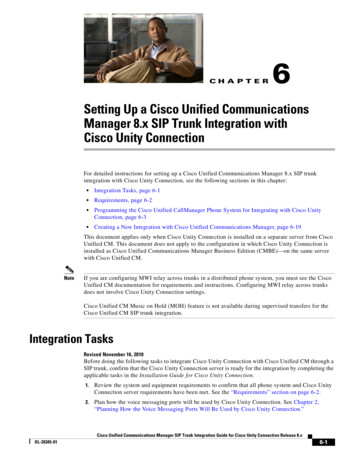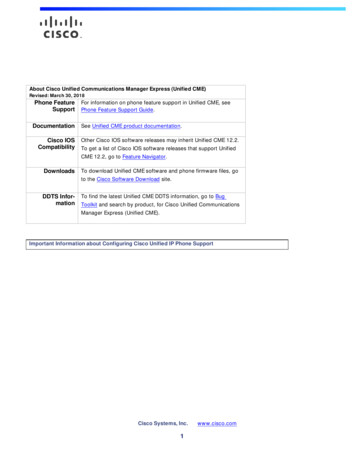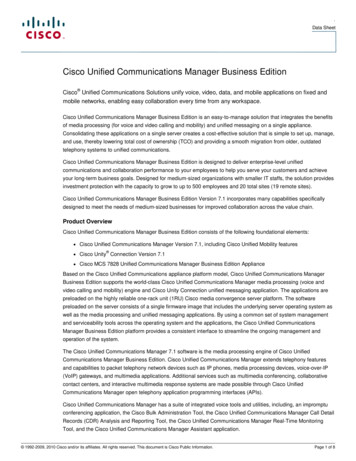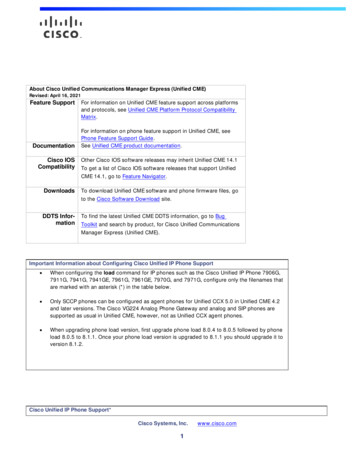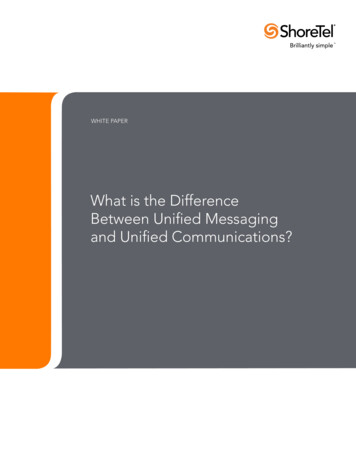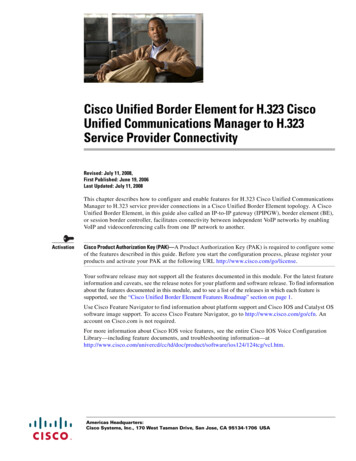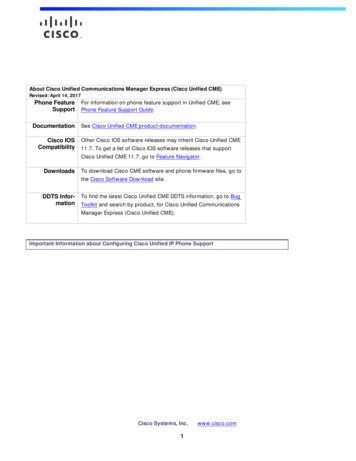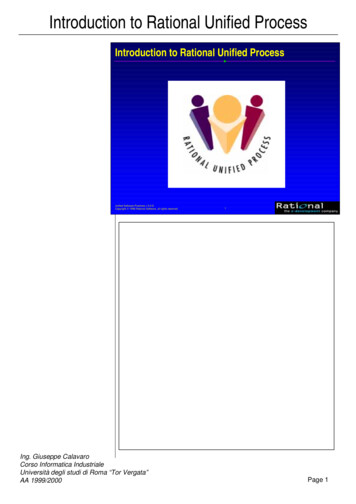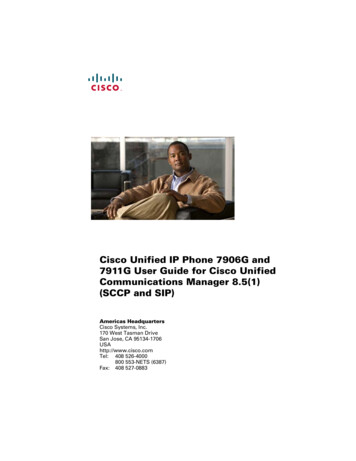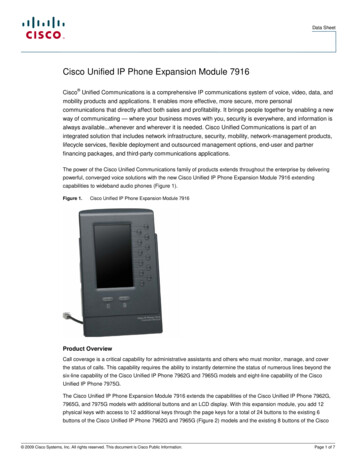
Transcription
Why a Unified K-12Talent ManagementSystem is Necessaryfor Student SuccessBy Melva Cárdenas,PowerSchool Strategic Education Advisora
ContentsWhat is talent management? . 2Components of a K-12 talent management system . . . . . . . . . . . . . . . . . . . . . . . . . . . . . . . . . . . . . . . . . . . . . . . . . . . 3How can a talent management system help improve student achievement? . . . . . . . . . . . . 4Top challenges & how a talent management system can overcome them . 5Benefits of a unified talent management system . . . . . . . . . . . . . . . . . . . . . . . . . . . . . . . . . . . . . . . . . . . . . . . . . . . . . 7Assessing your talent management needs . 9Questions to consider as you assess your talent management needs . . . . . . . . . . . . . . . . . . . . . . . 10Staying ahead with one unified platform . 13Why PowerSchool Unified TalentTM? . 14About Melva V. Cárdenas . 161
What is talentmanagement?What is now referred to as "talent management"has evolved over time.Dating back to the 1970s, the roleof the "personnel department" wasprimarily to hire staff and providecompensation and benefits.1960195019801970200019902010By the 1980s, the personnel department evolvedto become "human resources" (HR), which grewto include recruiting, applicant tracking, hiring,and training. Additionally, HR designed andmanaged job roles within the organization as wellas developed compensation packages partneringwith, and supporting, the business function.1. Josh Bersin (2007). Talent Management Changes HR.2Most recently, HR has evolvedto "talent management." WhileHR functions are a major focus,talent management integratesvarious HR "silos" to providea "continuous and integratedprocess for recruiting, training,managing, supporting, andcompensating staff."1
According to Josh Bersin, President and Founder of Bersin & Associates, a leading industry researchand advisory firm in enterprise learning and talent management, "Talent management may be defined asthe implementation of integrated strategies or systems designed to improve processes for recruiting,developing, and retaining people with the required skills and aptitude to meet current and futureorganizational needs." 1In K-12 education, the systems (or tools) that today’s talent management professionals use include softwarecovering each important function of the job role. While each can function individually for a specific need, aunified "talent management system" can integrate together to share data and increase functionality.Components of a K-12 talent management system include:Recruitment Job posting sites Job search engines Teacher successindicatorsIntegrationwith financial/compensationmanagementsystemsApplicant trackingsystem (ATS)Retention/Employee lifecyclemanagement Onboarding Employee recordsmanagement includingcontractsRetention Performancemanagement (evaluation) Professional developmentand learning1. Josh Bersin (2007). Talent Management Changes HR.3Substitutetracking
How can a talent management systemhelp improve student achievement?An effective talent management system should include solutionsfor recruiting, applicant tracking, performance management,professional learning, and compensation. This type of unifiedsystem can work together to improve student achievement in thefollowing ways:Finding the right teachers for student success.A product that evaluates cognitive abilities, teaching skills,and attitudinal factors is essential to attract and retainteachers and administrators who will have the greatest impact onstudent performance. By selecting the candidate most qualifiedand the right fit for the assignment, districts and schools canimprove teacher retention and ensure students are continuouslysupported with effective instruction.Improving teacher effectiveness. A comprehensive solutionfor performance management and professional learning isvital to developing successful teachers. It’s critical to providetargeted and timely feedback based on a teacher’s performanceto improve their effectiveness. It’s also key to analyze teacherperformance data and to link the results directly to professionallearning opportunities as well as student performance. Campusadministrators must have access to performance data to diagnoseareas of strength and need, and to inform relevant professionallearning. Providing differentiated and individualized professionallearning targets specific areas and makes the learning meaningful.Giving teachers and administrators more time tofocus on what’s important. By improving efficiencyand effectiveness using talent management technology,teachers and students benefit. Whether in the process ofrecruiting, selecting, evaluating, or developing your staff, acomprehensive talent management solution will give time back tobusy administrators and teachers. Rather than using a one-sizefits-all approach, a tailored professional learning plan based onteacher and student performance data creates more effective andsuccessful teachers. Not only is teacher time respected and trustestablished with greater transparency, but it creates a positiveschool culture where collaboration is fundamental, teacher time isrespected, and transparency fosters trust is established.4
Top challenges and how atalent management systemcan address themWith a continual emphasis on accountability, schools anddistricts face many challenges with limited resources. K-12leaders, including HR and talent management leaders, arecompeting for top talent to improve student outcomes.Many schools and districts are turning to technology to:1 Recruit a broad pool of potential candidates2 Identify and hire those who will impact student success the most3 Onboard their new hires as quickly and efficiently as possible4 Help them succeed by providing collaborative evaluation processes, ongoing feedback, andtargeted professional learning in an effort to improve teacher retention5
Effectively managing talent can have manyobstacles. The Center for American Progress(CAP) conducted a survey highlighting someof the challenges facing school districts,which include: 2 Recruiting strategy doesn’t align withtargeted area of need. Districts oftenimplement recruitment strategies thattend to focus on their local area or withintheir state. As a result, they may not betargeting specific content areas of need ormay not be focusing on recruiting a diversecandidate pool. Lack of emphasis on multiple candidatereview factors. When reviewing an applicantpool, emphasis is often on the writtenapplication, resume, and certification.Top candidates can be overlookedwhen performance-based tasks and/orbehavior-based questions are not availablefor consideration. Incomplete, ineffective onboarding process.Once hired, too much focus on paperworkcan negatively impact the onboardingprocess. Without an effective onboarding andmentoring program, teachers are not set upfor success on the job. Insufficient professional developmentopportunities. In addition to the onboardingand mentoring of new hires, teachersmay not have opportunities for—or accessto—professional learning that supportstheir growth.In addition to the challenges cited in theCAP survey, other issues include:District departments may be inundatedwith paper processesApplicant pools are often limited,particularly for hard-to-fill positionswith critical shortages Poor retention planning. The lack ofstrategic recruiting initiatives detracts fromcreating supportive environments that canimprove retention.Lack of automated or online processesmay discourage younger candidatesfrom applyingBudget cuts and staff reductions areforcing districts to do more with less2. Annette Konoske-Graf, Lisette Partelow, and Meg Benner (2016). ToAttract Great Teachers, School Districts Must Improve Their HumanCapital Systems.6
Benefits of a unified talent management systemAs schools and districts have shifted focus from personnel to HR to talent management, a unifiedsystem can help tackle changing needs. With a comprehensive, integrated system, vital processesare connected. K-12 leaders have the benefit of employee recruiting, onboarding, professional learning,performance, collaboration, and compensation combined in one, secure system.An integrated system doesn’t just provide more features and functionality. It also takes those addedelements and multiplies capabilities through improved efficiency, smooth workflows, and connected data.In the end, productivity is enhanced, allowing educators to get more done.ROI Benefits of PowerSchool Unified Talent3For a school or district of 2,700 students and 500 employees,typical cost savings can exceed 974,000 per yearless time spentcreating andposting new jobpositions40%50%50%eduction in timefasterfaster time-totime-tofill ratesratesfillreduction in timespentspent 50%50%less time50%50%less time creating,60%less time spent90%less time stasksless time creating,tracking,andtracking, andmanagingmanagingcontractscontracts3. Talent Management’s ROI in K-12 Education (2016). Hobson & Company.7less time spentcompletinglifecyclecompleting lifecyclemanagementmanagementtasks
A unified talent management system can help you:Find and retain quality teachers and other school staff with products that combine candidateassessment and applicant tracking capabilities so you can quickly find and hire great teachers.Conduct meaningful, engaging teacher evaluations and supervision that can identifystrengths and growth opportunities. This data, combined with student performance results,informs instruction as well as personalized professional learning paths, and in the end, impactsteacher retention and student achievement.Improve efficiencies by eliminating paper-based processes for things like recruitment,onboarding, evaluations, absence management, and beyond. A unified HR workflow simplifiesevery process and task, giving you more time back to focus on impacting student success.Centralize HR operations to increase visibility and ensure compliance in staff performanceand personnel management. When you connect HR with payroll and finance products, you canimprove decision-making and streamline administrative processes across the entire district.A unified talent management system has similar functionality between and among solutions. It affords theopportunity to begin the onboarding process for new hires early, which will provide the employee with thetools and knowledge to be successful.Having an electronic signature functionality adds to the efficiency and timeliness of completing tasks.Rather than using time-consuming manual processes for gathering data from multiple solutions, data canbe gathered more efficiently using the reporting and analytics functions of a talent management system.Data can then be easily analyzed to make informed decisions on forecasting recruitment needs, assessingrecruitment initiatives, teacher effectiveness, professional learning needs and offerings, and equity issues.Data security, interoperability, reduction in paper-based processes, alignment of goals, and talentdevelopment are a few additional benefits of a unified talent management system.8
Assessing your talentmanagement needsAn applicant tracking system (ATS) provides job statusesand action items in one place that are readily available andeasy to read.When the ATS is compatible on any device, including mobile devices, candidates can apply for jobs at theirconvenience from wherever they are. Having efficient recruiting, application, and onboarding processes canreduce your turnover rate, improve retention, and lower the costs associated with turnover.Retention is also improved when implementing a performance management system that offerstransparency and opportunities for ongoing feedback, as well as a professional learning system that can belinked to performance management for targeted, personalized training.OnboardingPerformance managementProfessional learningRecruiting andonboarding leads togreater retention ofnew hires, reducingturnover andhiring costs.Managers can easily help theiremployees set objectives, assessemployee progress, and providecoaching and feedback to helpensure employees are meetingtheir goals.By strategically and costeffectively creating, managing,and delivering personalizedtraining to employees, you canimprove employee engagementand retention.9
Questions to consider as you assess yourtalent management needs:PAIN POINT: Are you struggling with hiring the right staff?LOOK FOR: A product to help you scientifically look at candidates andprioritize them based on their likelihood to impact student success.RecruitingRECOMMENDATION: The assessment tool should assess thecandidate’s teaching skills, cognitive abilities, and attitudinal factors, andprovide a score for each as well as an overall score. Rather than sortingapplications alphabetically, sort by score to move higher-qualified candidatesto the top.PAIN POINT: Is your onboarding process limited to paperwork and lackingefficient workflows?OnboardingLOOK FOR: A product that will allow you to involve all departments with arobust workflow that eliminates paper-based processes.RECOMMENDATION: An effective onboarding process helps new hiresacclimate to the new working environment including social, cultural, andperformance aspects, as well as fill in necessary forms.10
PAIN POINT: Are you inundated in paper (i.e. personnel files, I-9s, W-2s,contracts, etc.)?RecordsManagementLOOK FOR: A product that provides electronic personnel files andfolders within the file to organize the various documents. The contractsfeature should allow the employee to view, sign, and submit the contractelectronically by logging into the individual’s account. The product should alsoprovide a self-service feature for employees to access forms and to submitthem electronically.RECOMMENDATION: Filing the traditional, manual way, receiving requestsfor forms, and sending the forms can be time- and labor-intensive. Save timeby creating workflows that route the document to the person who needs itand then route it directly to the electronic personnel file folder.PAIN POINT: Do your campus administrators find it challenging to getquantifiable insights into factors that impact student outcomes, which inturn can inform instruction and professional development plans?PerformanceManagementLOOK FOR: A product that delivers reports and analytics supporting stateand local educator effectiveness priorities. It should also be integrated with aprofessional learning tool to recommend and/or require targeted professionallearning opportunities, making it easy to understand and improveinstructional quality.RECOMMENDATION: Implementing a quality performance managementsystem will improve and strengthen performance managementprocesses by supporting rubric-based effectiveness models, focusing ontransparency and accountability, capturing multiple measures of evidence(i.e. observations, ad-hoc walk throughs, peer reviews, self-assessments,student achievement data), providing a mechanism for ongoing feedback,and connecting to professional learning.11
PAIN POINT: Is your school or district struggling to provide personalized,targeted professional learning opportunities linked to the teacher’s evaluationresults and students’ performance?ProfessionalLearningLOOK FOR: A product that naturally integrates with a performancemanagement system, enabling schools and districts to connect strengthsand weaknesses identified in the evaluation process with targetedprofessional learning.RECOMMENDATION: A professional learning system that is accessibleanytime, anywhere helps teachers choose courses and opportunitiesaligned with their learning goals and their evaluation results to impactstudent success. A quality professional learning system simplifies educatordevelopment by bringing together growth plans, coursework, and resourcesinto a single system.PAIN POINT: Are you having difficulty managing and assigning substituteswho are the most qualified and the best-fit for the assignment, as well asidentifying their availability?AbsenceManagementLOOK FOR: An absence management system that completes automatedcalling based on unique needs, such as the substitute’s qualifications and/orpreferences, the teacher’s preferences, and/or the nature of the vacancy. Alsolook for strong reporting functions to gain visibility into absence trends.RECOMMENDATION: Don’t waste time calling substitutes who are notavailable. By filling the vacancy quickly and efficiently with the most qualifiedcandidate available, instruction is not interrupted and students can progresson their learning path. A system that is easy to use for the substitute, theteacher, and the principal will decrease the amount of time it takes to fillan absence.12
Staying aheadwith one unifiedsolutionTalent management has evolvedover the years.To stay ahead, and ultimately drive student success,it’s essential to invest in a unified talent managementsystem to efficiently manage the many roles, tasks, andareas of responsibility that go far beyond simply hiringstaff and providing compensation and benefits.A unified system provides a platform that integratesprocesses—leading to improved instruction, teacherretention, and student achievement. Here’s what a unifiedsystem helps with:1 Recruiting teachers who are most likely to have thegreatest impact on student success2 Effective and efficient onboarding that provides theemployee with information and support needed tosucceed on the job3 Evaluating performance and providing tools for timelyfeedback and collaboration4 Developing teachers and improving instruction throughtargeted professional learning using data analyticsfrom the teacher’s evaluation results5 Data analysis across solutions allows administrators toimprove instructionThese processes, and the exchange of data, can beimplemented with confidence when you have a safe,secure talent management system.13
Why PowerSchoolTMUnified Talent ?K-12 HR leaders face the constant challenge of finding, hiring, andsupporting quality teachers and staff to positively impact studentachievement. To get there, unified edtech tools that work together—and are easy to implement—enhance school and district success.With 30 years of edtech leadership, PowerSchool is the single, trusted K-12 HR partner for:HR management tools for every phase of employment, from hire to retireEnabling tailored professional learning guided by student performance insightsWorld-class support and services for smooth implementations and ongoing partnershipA flexible, configurable solution for specific school ordistrict needsTM14
Using the combination of Unified Talent products they need, schools and districts can build acustomized solution to transform talent management into a data-driven function, ultimatelyfueling student achievement.Find and retain high-quality educators with the nation’s most popular K-12 job posting site,research-based candidate assessments, and an easy-to-use applicant tracking system.Boost educator effectiveness by identifying teacher strengths and opportunities for growth toprovide meaningful, actionable feedback. Provide personalized professional learning informed bypowerful student performance data from PowerSchool Performance Matters Assessment andAnalytics products to support educator growth and teacher retention.Get time back to focus on what really matters by drastically increasing HR efficiency. Move paperbased processes online for recruiting, onboarding, evaluations, absence management, and more.Embrace streamlined, digital HR workflows so staff can focus on impacting student success.Increase transparency into staff operations and ensure compliance in staff performance andpersonnel management by centralizing HR operations with a unified solution that brings it alltogether. Easily connect PowerSchool finance and payroll products to improve decision-making andeliminate redundancies at the school or district office.Build a positive school culture through systems that promote evaluation, feedback, and growth.Let collaboration flourish, help parent-teacher relationships thrive, and see teacher developmentdirectly impact student outcomes.15
Melva V. CárdenasA 33-year veteran educator and HR leader, Melva Cárdenas held roles as ateacher, principal, and HR executive director in Midland and Round RockIndependent School Districts, both in Texas. She currently serves as a fieldsupervisor for an educator certification program and a strategic educationadvisor at PowerSchool.Since retiring from the public schools in 2008, she served as director ofeducator certification at the Texas Education Agency (TEA) and executivedirector for the Texas Association of School Personnel Administrators (TASPA).Melva earned a Bachelor of Science in elementary education and a Masterof Education in school administration from Sul Ross State University inAlpine, Texas. She holds Texas educator certificates in elementary grades1-8 with Bilingual and English as a Second Language endorsement and midmanagement administrator. She is a certified T-TESS appraiser and trainer.16
At PowerSchool, we believe in the simple truth that every studentdeserves the best opportunities in life. That’s why our mission is to power theeducation ecosystem with unified technology that helps educators and students realizetheir potential, in their way. From the office to the classroom to the home, PowerSchoolhelps schools and districts efficiently manage instruction, learning, grading, attendance,assessment, analytics, state reporting, special education, student registration, talent,finance, and HR. Today, we’re proud to be the leading provider of K-12 education applicationtechnology supporting over 45 million students in over 70 countries.www.PowerSchool.com17HR-eb-016-100919
3 According to Josh Bersin, President and Founder of Bersin & Associates, a leading industry research and advisory firm in enterprise learning and talent management, "Talent management may be defined as the implementation of integrated strategies or systems designed to improve processes for recruiting,

